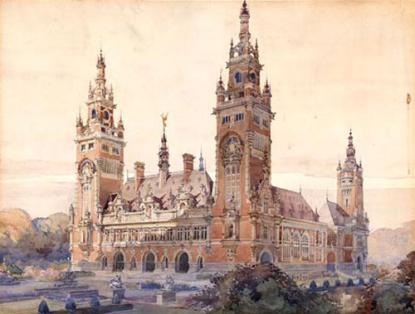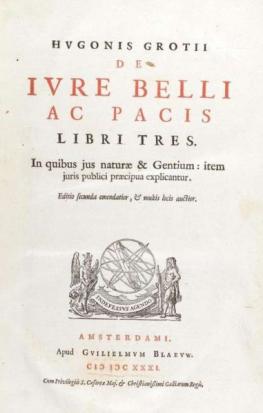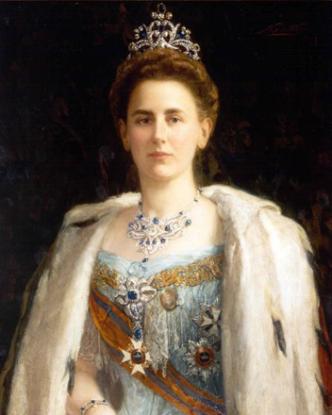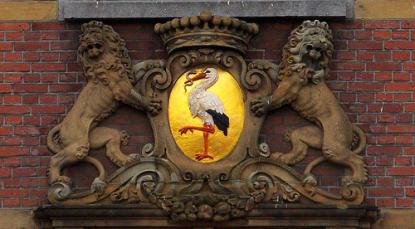Isn’t it nice to know that the city of one’s birth takes as its motto, “City of Peace and Justice?” I am very proud of that. That The Hague is also the place where the first Grand Pensionary (Prime Minister) of the Dutch Republic was executed after a trial in which he was allowed no defense, and the eighth, assassinated; where the socialist First International split between the Marxists and Anarchists in 1872; where Royal Dutch/Shell, a company that didn’t have a problem doing business with the Apartheid regime of South Africa, has its headquarters; where The Netherlands ruled its empire including the colonies of Indonesia and Surinam — we tend to forget in the excitement about the alphabet soup of courts that is rising like a Phoenix from the dusty ashes of empire.
I grew up in an atmosphere of soot stained Fin-de-Siecle decay with a whiff of sic transit. A famous song (1964) wistfully populated my “city of empty palaces” with civil servants turning gray in service to their country and great novels similarly gathering dust in attics: a staid, boring, careful, utterly bourgeois has-been of a backwater.
But those “palaces,” the residences of the great of the eighteenth-and nineteenth-century (European) world, aren’t all that empty these days. They house a multitude of agencies – deftly explicated in Martin Newhouse’s blog earlier this week on the international justice system.
Oddly enough, it was the presence of a twentieth-century edifice that brought the change. The Peace Palace, home of the Permanent Court of Arbitration, was built between 1907 and 1913 with a gift from steel magnate Andrew Carnegie. A picture of this over-the-top Neo-Renaissance piece of bad taste accompanies Martin’s blog, and here it is in the watercolor painting that became the winning entry in the site’s design contest.

How did the dull (so called by Queen Sophie of the Netherlands in her letters) government center of an insignificant country that will be under water within the next 50 years become the center of international justice?
Hugo de Groot, known as “Grotius,” wrote his treatise Mare Liberum, in which he formulated the principle that the sea was international territory, while employed by the Estates General (the government of the Dutch Republic) between 1599 and 1618. Unfortunately, Grotius became embroiled in the same conflict that cost the first Grand Pensionary, his afore-mentioned head. Grotius, purveyor of dangerous ideas, was locked up for life in a newly anointed state penitentiary (with a state comes a penitentiary), but escaped in a trunk of books. I am happy to report that, unlike the other two prisons I have blogged about, Slot Loevestein is a museum. Upon his escape Grotius went into exile – and he wrote De Jure Belli ac Pacis (On the Law of War and Peace,) establishing the concept of international law. He did not return until he was buried in Delft. His books are…guess where? The point being … we are proud of Grotius in The Hague now that we are committed to Justice.
the principle that the sea was international territory, while employed by the Estates General (the government of the Dutch Republic) between 1599 and 1618. Unfortunately, Grotius became embroiled in the same conflict that cost the first Grand Pensionary, his afore-mentioned head. Grotius, purveyor of dangerous ideas, was locked up for life in a newly anointed state penitentiary (with a state comes a penitentiary), but escaped in a trunk of books. I am happy to report that, unlike the other two prisons I have blogged about, Slot Loevestein is a museum. Upon his escape Grotius went into exile – and he wrote De Jure Belli ac Pacis (On the Law of War and Peace,) establishing the concept of international law. He did not return until he was buried in Delft. His books are…guess where? The point being … we are proud of Grotius in The Hague now that we are committed to Justice.
Law, especially international law, is suspect in the grand scheme of things Christian (the western world). If you practice law, you walk on the edge between what is okay and what isn’t. Perhaps more importantly, you know where that edge is. I need not remind you of that tree in the Garden. Many of us, and this is very clear in American political discourse, cast a jaundiced eye on the lawyer’s core activities of negotiation, and compromise: if you negotiate, your goal is practical rather than ideal. If you compromise, you might end up chucking that which is good for that which works. We like the law to be as clear as the Old Testament (“Thou shalt not steal”), but deep down we know that what the lawyer does is defining what might and might not be stealing, and by extension asking a dangerous question: was God really addressing all of us with “Thou?”
* * *
The Hague became a world political headquarters, not because it was a rich city in the center of things, but because it was not. The Counts of Holland, who built the castle that now forms the seat of Dutch government, did so (historians argue) because it was not a full-fledged city with rights. No mighty city regents in the picture.
 The town never became a trading or industrial center, nor does it have a university. The Oranges and other royals, stadtholders, and parliaments that governed the various incarnations of The Netherlands, largely continued to keep their courts in The Hague until today. The Dutch were a rich lot in the seventeenth and eighteenth centuries, and consequently The Hague became an international city with hordes of diplomats, ambassadors, and hangers-on who built all those “palaces.”
The town never became a trading or industrial center, nor does it have a university. The Oranges and other royals, stadtholders, and parliaments that governed the various incarnations of The Netherlands, largely continued to keep their courts in The Hague until today. The Dutch were a rich lot in the seventeenth and eighteenth centuries, and consequently The Hague became an international city with hordes of diplomats, ambassadors, and hangers-on who built all those “palaces.”
Nineteenth-century Europe was in a continuous state of war, with new nation-states vying for supremacy. The Netherlands had moved off the world stage by the nineteenth century—though its large colonial holdings necessitated a large bureaucracy. This retreat brought relative peace — neutrality. Bureaucracy brought more palaces, though of a lesser sort, and all that expertise and know-how.
Which may have been why Tsar Nicholas II asked his eighteen-year-old cousin,
 Queen Wilhelmina, to use The Hague for a Peace Conference to regulate the affairs between nations (one of his advisors had attended The Hague Conference on Private International Law in 1893 and was impressed by the organizing savvy of the Dutch). The young queen was quite chagrined: having the conference in her residence meant as much as openly admitting that it was a safe place no one could object to, a non-entity. Nevertheless, the conference invitations went out from the two together.
Queen Wilhelmina, to use The Hague for a Peace Conference to regulate the affairs between nations (one of his advisors had attended The Hague Conference on Private International Law in 1893 and was impressed by the organizing savvy of the Dutch). The young queen was quite chagrined: having the conference in her residence meant as much as openly admitting that it was a safe place no one could object to, a non-entity. Nevertheless, the conference invitations went out from the two together.
International Peace Conferences were held in The Hague in 1899 and 1907. A third one was planned for 1915, but was canceled because of the start of World War I. At these conferences, attempts were made both to sign treaties that would result in peaceful relations or the avoidance of war to resolve conflicts, and to sign treaties about rules for making war. Theodore Roosevelt was one of the movers behind the 1907 conference, which confirmed the principle of arbitration from 1899 and updated the rules of the Geneva Convention (1864) to include such modern concepts as air war.
Afterwards, the road to legal war was clear: 20/20 hindsight tells me that the treaty signed at this conference laid down the rules for World War I, should arbitration fail–which everyone expected, since the nations of Europe were engaged in an extensive schoolyard negotiation. The Women's International League for Peace and Freedom did hold a conference at The Hague in 1915, but the organizers–including Jane Addams and Henry Ford–were attacked viciously by none other than Roosevelt himself.
And so it continued, PCA (1901), ICJ (1922), ICC (2002), ICTY, you name it. What was convenient, is that The Netherlands is an un-power with a hunger for influence: it remained neutral in World War I, was overrun in World War II, and is no longer an empire. Where neutrality had been the answer until 1939, negotiation became a way to keep standing during the second half of the twentieth century: the Polder Model of decision-making. Like law and neutrality, this is a suspect concept: if you want to achieve a practical solution through a process of consensus building, you have to be flexible in your commitment to your own ideas. A great place for Justice to hang out.
The Netherlands has made good business out of the re-emergence of international legal institutions after the Berlin Wall came down. Once the world started paying attention again (it had been largely asleep, or perhaps diverted by the need to reign in the Communist menace, since world War II), The Hague became the obvious spot to house the special courts on genocides in its empty palaces and newer buildings. The backwater military base of my youth–slated to be closed in the detente that came with the fall of the Wall–suddenly grew higher fences again. More that fifty percent of the population of The Hague was neither born nor bred Dutch. The Hague is as important as it has always been in its own eyes. Appropriate for a city whose emblem is the stork, no?



